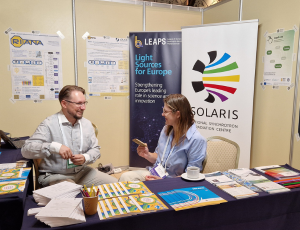 Web Content Display
Web Content Display
SOLARIS centre
 Web Content Display
Web Content Display
Removal of uranium and thorium from aqueous solutions
The ASTRA beamline was visited by a group of scientists from Lublin: Dr Agnieszka Gładysz-Płaska, Prof. Marek Majdan from the Maria Curie-Skłodowska University, Dr Ewelina Grabias-Blicharz and student Bartosz Płaska from the Medical University of Lublin in order to carry out very interesting research related to the removal of uranium and thorium from aqueous solutions on functionalized silica materials. The experiments concerned samples of silica and zeolite X filled with phosphorus ions, as well as non-radioactive forms of uranium and thorium (CH3COO)2UO2·2H2O and Th(NO3)4·6H2O respectively, purchased in Poland from ChMES SA. The measurements were performed with the cooperation and great engagement of Dr Alexey Maximenko, who supported them with his professional knowledge and advice.
The aim of the study was to determine the oxidation state for uranium, phosphorus and thorium in the used systems and their geometrical structure. The obtained results are of significant important for understanding the effect of phosphorus on binding of uranium and thorium, which is necessary to control the mobility of these elements in the environment due to their toxicity. Nowadays this issue is becoming more and more important in practice, as both uranium and thorium can be used as fuel in nuclear power plants. In the current situation of moving away from the production of electricity from burning coal, there becomes realistic the prospect of building a nuclear power plant in Poland and as a result generation uranium and thorium containing wastes. The removal of U(VI) from radioactive waste and groundwater near uranium mines is a serious problem due to the associated radioactivity and toxicity. Since the elements are poisonous to humans and the environment, long-term exposure or ingestion of U(VI) compounds can cause irreversible damage to bones and kidney or liver function. Thorium, like uranium, can be used as fuel in nuclear reactors. In addition, it is also a potential candidate for the nuclear fuel of the future, superior to the commonly used uranium. Research on the sorption and recovery of U(VI) and Th(IV) ions is crucial not only for their importance in the nuclear industry, but also for the protection of human health and the environment. An additional important aspect is the use of seawater as a reservoir for uranium, as it contains about 4.5 billion tonnes of this element. Extraction of greatly dilute uranium (3.3 ppb) is a difficult task and adsorption materials characterized by large selectivity and absorption capacity are still being sought. Currently, adsorption is the most popular method of removing actinides from the aquatic environment, mainly due to the low cost of treatment. Metal oxides, activated carbon, nanotubes and aluminosilicates are most commonly used as actinide sorbents. Silica and aluminosilicates (zeolites) are basic groups of adsorbents. They are inorganic, crystalline and porous materials with a well-defined structure. Phosphate ions are known to improve the sorption and extraction of U(VI) and Th(IV), so the researchers focused on the effect of modifying silica and aluminosilicates with phosphorus-containing ligands at different oxidation states: P(-1); P(+3); P(+5). The binding and immobilization mechanisms of U and Th are fundamental for understanding of both stabilizing capacity and potential for migration or development of repair strategies. Taking into account today's global problems related to energy demand, research on the sorption and recovery of U and Th is extremely relevant and important. XANES measurements are an excellent tool for analysis because they allow for a deeper insight into the sample. Thereby, understanding the modification of composite materials by the process of P and U(VI) or Th(IV) sorption requires XANES spectroscopy to study the local structure of solid-phase complexes. Based on previous studies and measurements, scientists have not been able to obtain accurate information to understand uranium adsorption capacity and its potential to migrate and develop recovery strategies. In addition, an important aspect of the measurements carried out is the fact that so far there is no XANES data available for thorium. Thereby, the research of a group of scientists from Lublin is somehow pioneering.
The users would like to express their special thanks to Dr Alexey Maximenko (ASTRA beamline supervisor) owing to whom the measurements were possible.



